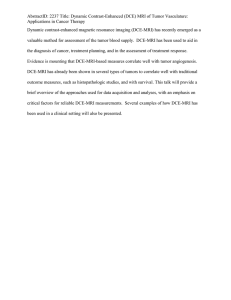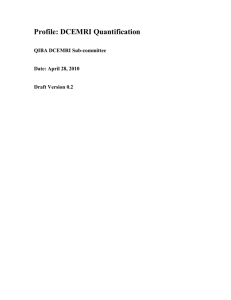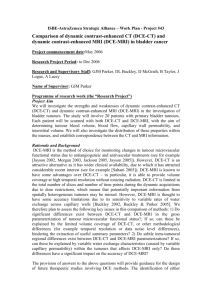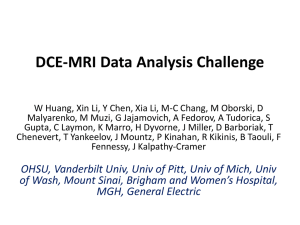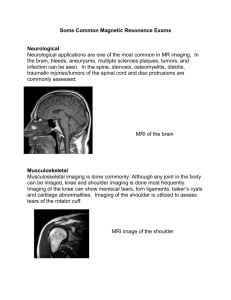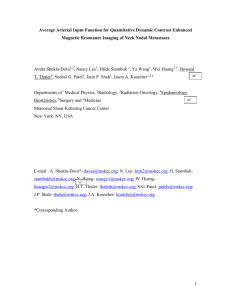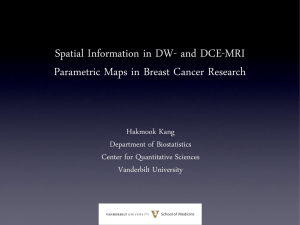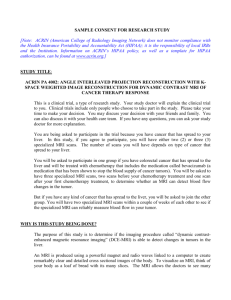43 CT DCE-MRI comparison - Personal Webpages (The University
advertisement
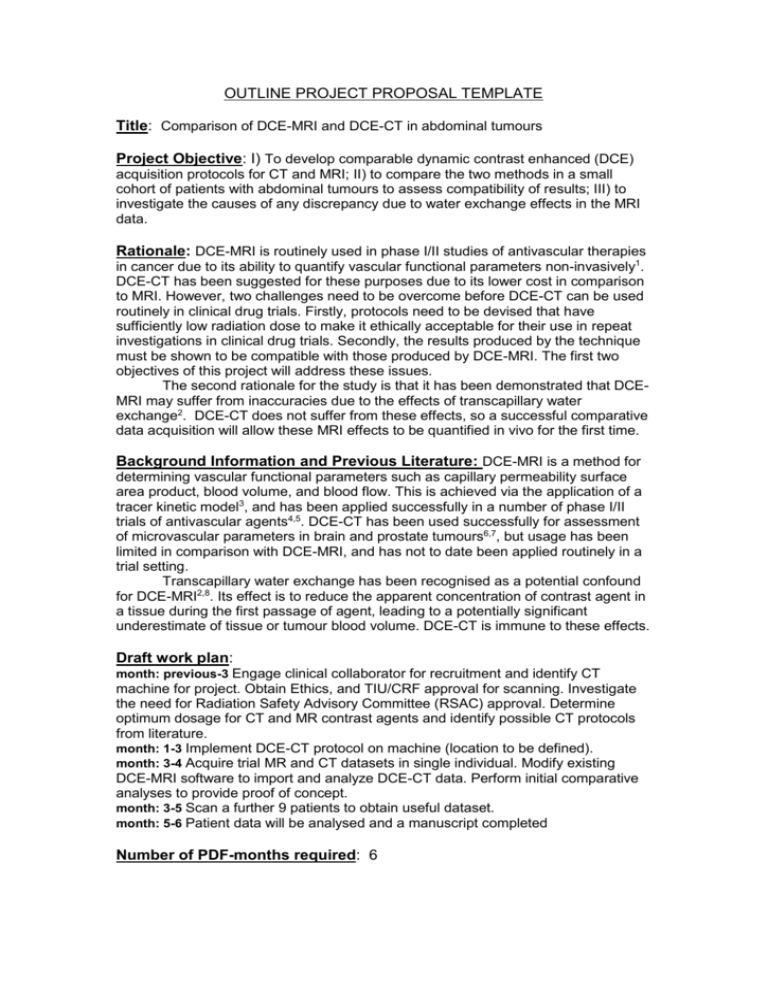
OUTLINE PROJECT PROPOSAL TEMPLATE Title: Comparison of DCE-MRI and DCE-CT in abdominal tumours Project Objective: I) To develop comparable dynamic contrast enhanced (DCE) acquisition protocols for CT and MRI; II) to compare the two methods in a small cohort of patients with abdominal tumours to assess compatibility of results; III) to investigate the causes of any discrepancy due to water exchange effects in the MRI data. Rationale: DCE-MRI is routinely used in phase I/II studies of antivascular therapies in cancer due to its ability to quantify vascular functional parameters non-invasively1. DCE-CT has been suggested for these purposes due to its lower cost in comparison to MRI. However, two challenges need to be overcome before DCE-CT can be used routinely in clinical drug trials. Firstly, protocols need to be devised that have sufficiently low radiation dose to make it ethically acceptable for their use in repeat investigations in clinical drug trials. Secondly, the results produced by the technique must be shown to be compatible with those produced by DCE-MRI. The first two objectives of this project will address these issues. The second rationale for the study is that it has been demonstrated that DCEMRI may suffer from inaccuracies due to the effects of transcapillary water exchange2. DCE-CT does not suffer from these effects, so a successful comparative data acquisition will allow these MRI effects to be quantified in vivo for the first time. Background Information and Previous Literature: DCE-MRI is a method for determining vascular functional parameters such as capillary permeability surface area product, blood volume, and blood flow. This is achieved via the application of a tracer kinetic model3, and has been applied successfully in a number of phase I/II trials of antivascular agents4,5. DCE-CT has been used successfully for assessment of microvascular parameters in brain and prostate tumours6,7, but usage has been limited in comparison with DCE-MRI, and has not to date been applied routinely in a trial setting. Transcapillary water exchange has been recognised as a potential confound for DCE-MRI2,8. Its effect is to reduce the apparent concentration of contrast agent in a tissue during the first passage of agent, leading to a potentially significant underestimate of tissue or tumour blood volume. DCE-CT is immune to these effects. Draft work plan: month: previous-3 Engage clinical collaborator for recruitment and identify CT machine for project. Obtain Ethics, and TIU/CRF approval for scanning. Investigate the need for Radiation Safety Advisory Committee (RSAC) approval. Determine optimum dosage for CT and MR contrast agents and identify possible CT protocols from literature. month: 1-3 Implement DCE-CT protocol on machine (location to be defined). month: 3-4 Acquire trial MR and CT datasets in single individual. Modify existing DCE-MRI software to import and analyze DCE-CT data. Perform initial comparative analyses to provide proof of concept. month: 3-5 Scan a further 9 patients to obtain useful dataset. month: 5-6 Patient data will be analysed and a manuscript completed Number of PDF-months required: 6 Non-staff costs: 10 MR scans at £633 per hour scan = £6330. CT scan costs to be determined, but will be considerably less than MR costs. Proposed start and end dates: start: Feb 2005, end: July/August 2005 Milestones: Clinician engaged and CT machine identified; Ethics and other regulatory documentation; development of DCE-CT protocol; acquisition of first dataset; establishment of analysis methods; analysis of data; report; manuscript. Outputs (1) Information sought for AstraZeneca: Assessment of whether DCE-CT and DCE-MRI outputs are compatible will allow decisions regarding the utility of DCE-CT in clinical drug trials. Outputs (2) Publication opportunities: Clinical comparison of potential publishable interest (radiology journal). Identification of water exchange limitations in DCE-MRI of publishable interest (radiology or MRI journal). ISMRM and RSNA submissions likely. Strategic fit (AstraZeneca): Clinical trials of antivascular agents using DCE-MRI are costly and the acquisition/analysis methods can be difficult. If DCE-CT can be shown to be as good/better than DCE-MRI, and that the radiation risks are not significant, this could lead to a significant cost reduction for trials. Data acquisition and analysis may be demonstrated to be slightly more straightforward than DCEMRI. Interest in this project has been expressed by Helen Young. Strategic fit (University): DCE-MRI is of major interest within the University, and an improved understanding of the limitations of the technique will allow future improved methods. DCE-CT, if shown to be useful, is likely to be of interest for future academic studies of tumour microvasculature. Interest in this project has been expressed by Geoff Parker, Alan Jackson, and David Buckley. Approvals required (Human subjects, animal subjects, IPR etc): Local Research Ethics Committee, RSAC, Translational Imaging Unit Approval, CRF approval. References 1. Jackson, A., Buckley, D. L. & Parker, G. J. M. (eds.) Dynamic contrastenhanced magnetic resonance imaging in oncology (Springer, Berlin, 2004). 2. Buckley, D. L. Transcytolemmal water exchange and its affect on the determination of contrast agent concentration. Magnetic Resonance in Medicine 47, 420-421 (2002). 3. Parker, G. J. M. & Buckley, D. L. in Dynamic contrast-enhanced magnetic resonance imaging in oncology (eds. Jackson, A., Buckley, D. L. & Parker, G. J. M.) 81-92 (Springer, Berlin, 2004). 4. Jayson, G. C. et al. Molecular imaging and biological evaluation of HuMV833 anti-VEGF antibody: Implications for trial design of antiangiogenic antibodies. Journal of the National Cancer Institute 94, 1484-1493 (2002). 5. Morgan, B. et al. Dynamic Contrast-Enhanced Magnetic Resonance Imaging As a Biomarker for the Pharmacological Response of PTK787/ZK 222584, an Inhibitor of the Vascular Endothelial Growth Factor Receptor Tyrosine Kinases, in Patients With Advanced Colorectal Cancer and Liver Metastases: Results From Two Phase I Studies. Journal of Clinical Oncology 21, 3955-3964 (2003). 6. Roberts, H. C., Roberts, T. P. L., Lee, T.-Y. & Dillon, W. P. Dynamic, contrast-enhanced CT of human brain tumors: quantitative assessment of blood volume, blood flow, and microvascular permeability: report of two cases. American Journal of Neuroradiology 23, 828-832 (2002). 7. Henderson, E., Milosovic, M. F., Haider, M. A. & Yeung, I. W. T. Functional CT imaging of prostate cancer. Physics in Medicine and Biology 48, 30853100 (2003). 8. Buckley, D. L. in Dynamic contrast-enhanced magnetic resonance imaging in oncology (eds. Jackson, A., Buckley, D. L. & Parker, G. J. M.) 69-80 (Springer, Berlin, 2004).
